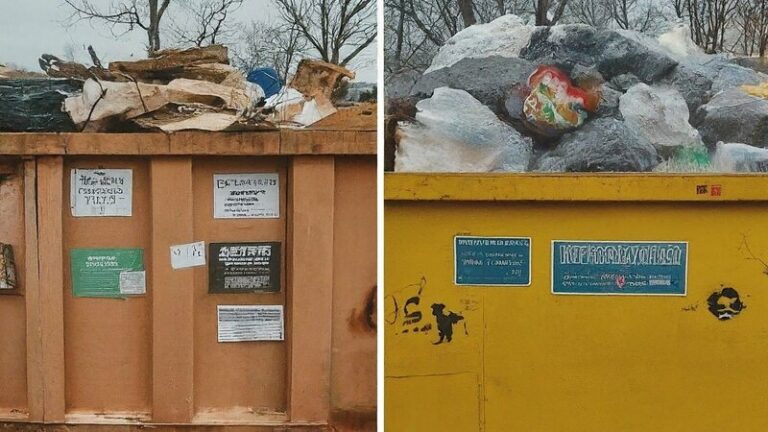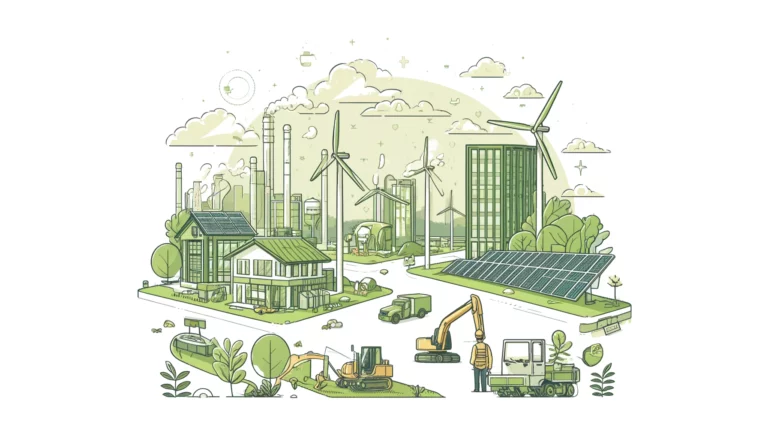Effective waste management in construction not only benefits the environment and society but also offers significant economic and operational advantages for construction companies. By prioritizing waste reduction, recycling, and responsible disposal practices, construction firms can enhance their competitiveness, protect their reputation, and contribute to a more sustainable future. This article gives an overview of waste management on construction sites with a focus on the role of construction estimating software.
Construction Project estimating software and cloud-based construction procurement software are essential tools in modern construction management. These technologies streamline processes, improve accuracy, and enable better decision-making throughout the project lifecycle
Global annual construction waste is expected to reach 2.2 Billion tons by 2025. Image credit:
Edgar Toro
How Estimation Software Helps Reduce Construction Waste
Estimation software plays a crucial role in reducing construction waste through several
mechanisms.
Accurate Material Quantification
Estimation software enables precise quantification of materials required for construction
projects.
By accurately predicting the quantity of materials needed, construction teams can minimize
over-ordering and excess inventory, thus reducing waste associated with unused materials.
Optimized Design and Planning
Estimation software allows construction professionals to conduct detailed analysis and planning
during the design phase of a project.
By optimizing designs and material specifications, teams can minimize the generation of waste
during the construction process.
Waste Tracking and Management
Estimation software often includes features for tracking and managing construction waste
throughout the project lifecycle. By monitoring waste generation, sorting, and disposal, teams
can identify opportunities to reduce waste and improve efficiency in waste management
practices.
Real-Time Data Insights
Many construction waste management software solutions like ConWize, provide real-time data insights and analytics capabilities. By leveraging these insights, construction teams can make informed decisions to optimize material usage, reduce waste, and improve project efficiency.
Integration with Building Information Modeling (BIM)
Estimation software may integrate with BIM platforms, allowing for more accurate and
coordinated planning and design.
By combining estimation data with BIM models, teams can identify potential clashes, optimize
material usage, and minimize waste during construction.
Scenario Analysis and Optimization
Estimation software enables construction teams to conduct scenario analysis and optimization
to identify the most cost-effective and sustainable solutions.
By exploring different design and material options before actual construction work begins, teams
can minimize waste generation while meeting project requirements.
Standardization and Best Practices
Estimation software often incorporates industry-standard methodologies and best practices for
waste reduction. By following these standards, construction teams can ensure consistency and
efficiency in waste management practices across projects.
By leveraging these capabilities, construction teams can minimize waste generation, improve
project efficiency, and contribute to a more sustainable built environment.
The Benefits of Waste Management in Construction
Cost Savings
Effective waste management can significantly reduce project costs. By minimizing waste
generation, recycling materials, and optimizing disposal methods, construction companies can
save money on purchasing new materials and paying for waste disposal services.
Environmental Protection
Construction activities generate a significant amount of waste, including debris, packaging
materials, and unused materials.
Proper waste management practices help reduce the environmental impact of construction
projects by minimizing pollution, conserving resources, and reducing greenhouse gas emissions
associated with waste disposal.
Compliance With Regulatory Requirements
Many jurisdictions have regulations governing the management and disposal of construction
waste. Compliance with these regulations is essential to avoid fines, penalties, and legal
liabilities.
Implementing effective waste management practices ensures compliance with local, state, and
federal laws, protecting the company from legal issues.
Reputation and Stakeholder Relations
Adopting sustainable waste management practices can enhance a construction company’s
reputation and improve relationships with stakeholders, including clients, investors, regulators,
and the community.
Demonstrating a commitment to environmental responsibility and sustainability can differentiate
a company from its competitors and attract environmentally conscious clients.
Worker Safety and Health
Proper waste management practices contribute to a safer and healthier work environment for
construction workers.
Minimizing the accumulation of waste reduces tripping hazards and the risk of accidents.
Additionally, handling hazardous materials safely and implementing appropriate disposal
procedures protects workers from exposure to harmful substances.
Resource Conservation and Circular Economy
Construction projects consume vast amounts of natural resources, including timber, minerals,
and fossil fuels.
By reducing waste generation and promoting recycling and reuse of materials, waste
management contributes to resource conservation and promotes a circular economy model.
Reusing materials such as concrete, wood, and metals reduces the need for virgin resources
and minimizes the environmental impact of resource extraction and processing.
Enhanced Innovation and Efficiency
Embracing innovative waste management technologies and practices can lead to increased
efficiency and productivity in construction projects.
Advanced sorting and recycling technologies, prefabrication techniques, and waste-to-energy
systems can streamline waste management processes, reduce project timelines, and improve
overall project performance.
Sustainability and Corporate Social Responsibility (CSR)
Integrating sustainable waste management practices into construction projects aligns with
broader corporate social responsibility initiatives and sustainability goals.
By minimizing waste, conserving resources, and reducing environmental impact, construction
companies contribute to the transition toward a more sustainable and resilient built environment.
Factors to Consider When Choosing Estimation Software That Will Help Reduce Construction Waste
When selecting estimation software to help manage waste effectively in construction projects,
consider the following key features.
Material Quantification and Tracking
Look for software that accurately quantifies and tracks materials throughout the project lifecycle.
This includes features for estimating material quantities based on project specifications, tracking
material usage and inventory levels, and monitoring waste generation and disposal.
Integration with Building Information Modeling (BIM)
Choose software that integrates seamlessly with BIM platforms, allowing for coordinated
planning and design.
Integration with BIM enables more accurate estimation of material requirements, identification of
potential clashes or inefficiencies, and optimization of material usage to reduce waste.
Real-Time Data Insights and Analytics
Opt for software that provides real-time data insights and analytics capabilities. This includes
features for analyzing historical data, identifying trends and patterns in material usage and
waste generation, and generating actionable insights to optimize waste management practices.
Scenario Analysis and Optimization
Look for software that supports scenario analysis and optimization to identify the most cost-
effective and sustainable solutions.
This includes features for exploring different design and material options, evaluating their impact
on waste generation and project costs, and selecting the optimal solution based on predefined
criteria.
Robust Waste Tracking and Management Features
Choose software that includes robust features for tracking and managing construction waste.
This includes features for categorizing and sorting waste, recording waste generation and
disposal activities, tracking waste diversion and recycling efforts, and generating reports and
documentation for regulatory compliance.
Mobile Accessibility and Field Connectivity
Consider software that offers mobile accessibility and field connectivity, allowing project teams
to access and update waste management data from anywhere, at any time.
This includes mobile apps or cloud-based platforms that enable field workers to input data,
capture photos, and report waste-related activities in real time.
User-Friendly Interface and Customization Options
Look for software with a user-friendly interface and customizable options to suit the specific
needs and preferences of your organization.
This includes features for customizing estimation templates, defining waste categories and
disposal methods, and tailoring reports and dashboards to meet your reporting requirements.
Training and Support Resources
Ensure that the software vendor provides comprehensive training and support resources to help
users effectively implement and utilize the software for waste management purposes.
This includes user manuals, online tutorials, training sessions, and responsive customer support
services to address any technical issues or questions that may arise.
Frequently Asked Questions in Construction Waste Management
What Are the Methods Used to Estimate Waste Quantities?
Estimating waste quantities on construction sites typically involves methods such as:
● Visual inspection: Direct observation to identify and quantify waste materials.
● Historical data analysis: Reviewing past projects to estimate waste based on similar
parameters.
● Quantitative analysis: Measuring materials used versus actual waste generated.
● Waste tracking software: Utilizing specialized software to track and estimate waste
throughout the construction process.
● Predictive modeling: Using mathematical models to forecast waste generation based
on project specifications and other factors.
● Supplier input: Consultation with suppliers to estimate packaging and leftover material
quantities.
How Does BIM Reduce Waste?
Building Information Modeling (BIM) reduces waste by:
● Optimizing Design: BIM allows for detailed planning and analysis, reducing over-
ordering of materials and minimizing design errors that lead to waste.
● Improved Coordination: Better coordination among project stakeholders through BIM
reduces clashes and rework, reducing material wastage.
● Efficient Construction Processes: BIM facilitates better scheduling and sequencing of
construction activities, minimizing downtime and resource inefficiencies.
● Quantification and Tracking: BIM enables accurate quantification and tracking of
materials throughout the project lifecycle, aiding in waste reduction efforts.
● Prefabrication and Modular Construction: BIM supports prefabrication and modular
construction techniques, which can reduce onsite waste by optimizing material usage
and minimizing onsite cutting and trimming.
What Is the Most Common Waste Used in Construction?
The most common types of waste in construction include excess materials, packaging waste,
demolition debris, offcuts and trim waste, hazardous materials, surplus inventory, land clearing
debris, plasterboard waste, and metal scrap.
Efficient waste management practices aim to minimize the generation of these wastes through
strategies like waste reduction, reuse, recycling, and proper disposal.
How Do You Manage Waste on a Construction Site?
Waste management on a construction site involves several steps:
● Waste minimization. Reduce waste generation by optimizing design, planning, and
material usage.
● Sorting and segregation. Separate different types of waste materials to facilitate
recycling and proper disposal.
● Reuse and recycling. Identify opportunities to reuse materials on-site or recycle them
through appropriate channels.
● Proper disposal. Dispose of non-recyclable waste in accordance with local regulations
and guidelines.
● Monitoring and documentation. Track waste generation, disposal, and recycling
efforts to ensure compliance and improve efficiency.
● Employee training and awareness. Educate construction workers about waste
management practices and encourage their active participation in waste reduction
efforts.
What Are the Eight Sources of Waste in Lean Construction?
In Lean construction, the eight sources of waste, often referred to as the “8 Wastes,” are:
- Transportation. Unnecessary movement of materials, equipment, or workers, leading to
inefficiency and increased costs. - Inventory. Excess materials, equipment, or work-in-progress inventory that ties up
capital and increases storage costs. - Motion. Unnecessary movement or actions by workers, such as excessive walking or
reaching, that waste time and energy. - Waiting. Idle time caused by delays in the construction process, such as waiting for
materials, equipment, or instructions. - Overproduction. Producing more than what is needed or before it is needed, leading to
excess inventory, wasted resources, and increased costs. - Overprocessing. Performing unnecessary or redundant tasks that do not add value to
the final product or service. - Defects. Errors, rework, or defects in construction work that require additional time,
materials, and resources to correct. - Underutilized talent. Not fully leveraging the skills, knowledge, and capabilities of
workers, leading to inefficiency and missed opportunities for improvement.
Identifying and eliminating these sources of waste is essential for improving efficiency, reducing
costs, and enhancing overall project performance in Lean construction.















